 | | 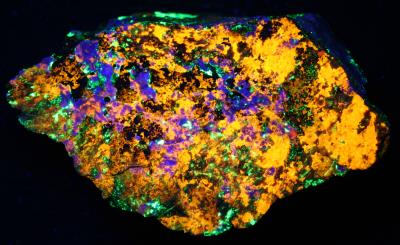 |
Clinohedrite, minor hardystonite, willemite, calcite, and franklinite from Franklin, New Jersey. Visible plates and coatings of clinohedrite are rare. Photo by JVF
| | Clinohedrite from Franklin, New Jersey under shortwave UV light. The clinohedrite fluoresces bright orange, hardystonite violet blue, willemite green and the calcite just a couple of spots of red. Photo by JVF |
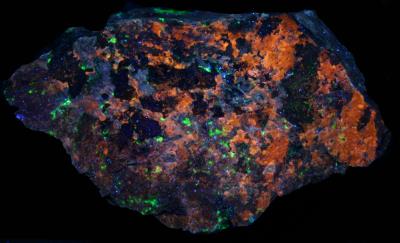 |
Clinohedrite from Franklin, New Jersey under longwave UV light. The clinohedrite fluoresces dull orange and willemite green. A strong longwave UV response (fluorescence) is uncommon. Photo by JVF
|
|
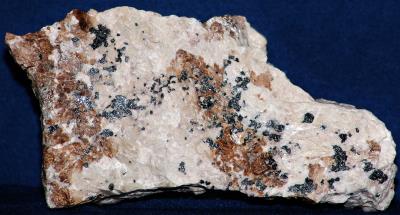 | | 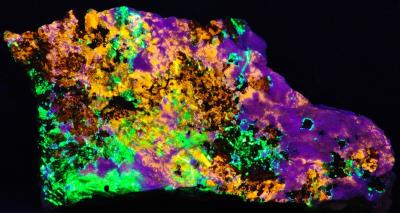 |
Clinohedrite, hardystonite, willemite, andradite garnet (brown) and franklinite (black) from Franklin, New Jersey. 5 3/4" x 4 1/4". From the collection of, and photo by Robert A. Boymistruk.
| | Clinohedrite, hardystonite, willemite, andradite garnet and franklinite from Franklin, NJ under shortwave UV light. The clinohedrite fluoresces bright orange, hardystonite violet blue, willemite green and the garnet and franklinite are non-fluorescent. 5 3/4" x 4 1/4". From the collection of, and photo by Robert A. Boymistruk. |
|
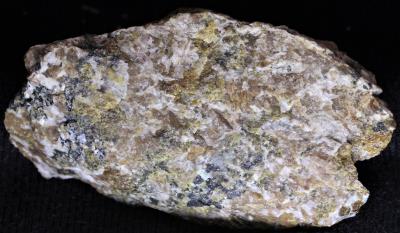 | |  |
Clinohedrite, hardystonite, willemite (tan, white), diopside(tan, zinc-schefferite), andradite garnet (straw) and franklinite (black) from Franklin, New Jersey. 2 1/4" x 1 1/4". Photo by WP.
| | Clinohedrite, hardystonite, willemite, diopside, andradite garnet and franklinite from Franklin, NJ under longwave UV light. The clinohedrite fluoresces dark orange, hardystonite very weak violet, willemite green and the diopside, garnet and franklinite are non-fluorescent. 2 1/4" x 1 1/4". Photo by WP. |
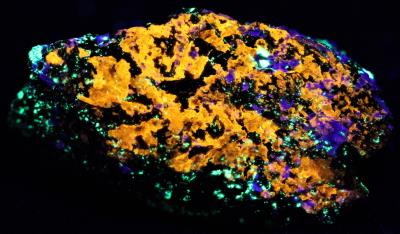 |
Clinohedrite, hardystonite, willemite, diopside, andradite garnet and franklinite from Franklin, NJ under shortwave UV light. The clinohedrite fluoresces bright orange, hardystonite violet blue, willemite green and the diopside, garnet and franklinite are non-fluorescent. 2 1/4" x 1 1/4". Photo by WP.
|
|
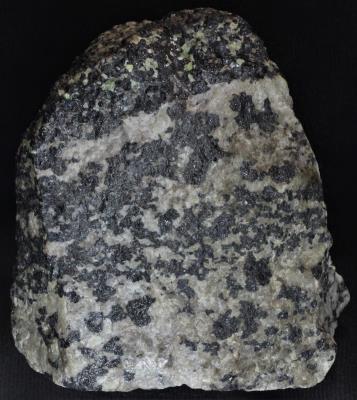 | |  |
Clinohedrite, hardystonite, willemite (green, white) and franklinite (black) from Franklin, New Jersey. 3" x 3 1/2". Photo by WP.
| | Clinohedrite, hardystonite, willemite and franklinite from Franklin, NJ under longwave UV light. The clinohedrite fluoresces weak light orange, hardystonite very weak violet, willemite green and the franklinite is non-fluorescent. 3" x 3 1/2". Photo by WP. |
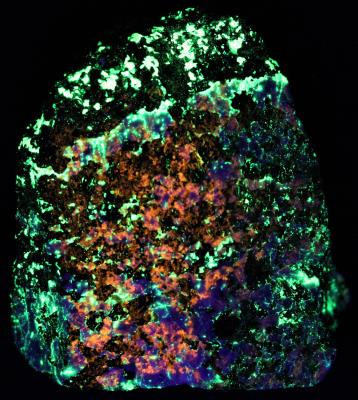 |
Clinohedrite, hardystonite, willemite and franklinite from Franklin, NJ under shortwave UV light. The clinohedrite fluoresces orange, hardystonite violet, willemite green and the franklinite is non-fluorescent. 3" x 3 1/2". Photo by WP.
|
|
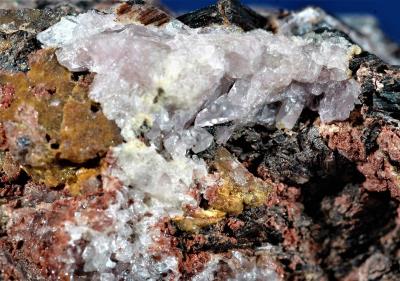 | | 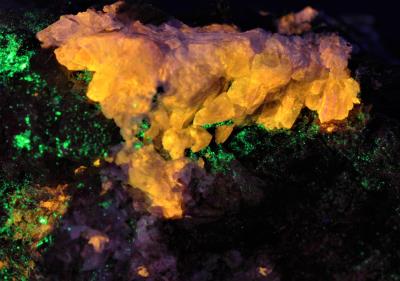 |
Amethystine clinohedrite crystals (light violet to clear), hancockite (reddish brown), andradite (golden brown), hendricksite (black), and minor willemite, from Franklin, NJ. Field of view 2 1/4". From the collection of, and photo by Robert A. Boymistruk.
| | Amethystine clinohedrite crystals, hancockite, andradite, hendricksite, and minor willemite, from Franklin, NJ under shortwave UV light. Field of view 2 1/4". The clinohedrite fluoresces yellow-orange and the willemite green. From the collection of, and photo by Robert A. Boymistruk. |
|
